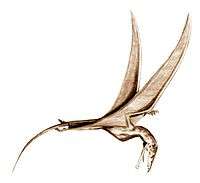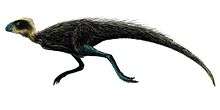Coelophysis kayentakatae
| Coelophysis kayentakatae Temporal range: Early Jurassic, 196 Ma | |
|---|---|
 | |
| C. kayentakatae feeding on a Scutellosaurus | |
| Scientific classification | |
| Kingdom: | Animalia |
| Phylum: | Chordata |
| Class: | Reptilia |
| Clade: | Dinosauria |
| Order: | Saurischia |
| Suborder: | Theropoda |
| Family: | †Coelophysidae |
| Subfamily: | †Coelophysinae |
| Genus: | †Coelophysis |
| Species: | †C. kayentakatae |
| Binomial name | |
| Coelophysis kayentakatae Rowe, 1989 | |
| Synonyms | |
|
Syntarsus kayentakatae Megapnosaurus kayentakatae | |
Coelophysis kayentakatae is an extinct species of coelophysid dinosaur that lived approximately 196 million years ago during the early part of the Jurassic Period in what is now the southwestern United States.[2] Originally included in the genus Syntarsus, a name which was later found to have already been in use for a species of insect. It has been reclassified as either Coelophysis or Megapnosaurus, along with the African species, Coelophysis rhodesiensis.[1]
The name C. kayentakatae refers to the Kayenta Formation, where all known fossil specimens have been found.
Description
C. kayentakatae had small two small, parallel crests and may show an evolutionary step toward later and larger neotheropods, such as the more advanced and larger Dilophosaurus. Both possess a "weak joint" between the premaxillary and the maxillary bones, creating a hooked premaxillary jaw.
Specimen UCMP V128659 was discovered in 1982 and referred to Syntarsus kayentakatae by Rowe in 1989,[3] as a subadult gracile individual and later, Tykoski (2005)[4] agreed. Gay (2010) described the specimen as the new tetanurine taxon Kayentavenator elysiae,[5] but Mortimer (2010) pointed out that there was no published evidence that Kayentavenator is the same taxon as C. kayentakatae.[6]
A diagnosis is a statement of the anatomical features of an organism (or group) that collectively distinguish it from all other organisms. Some, but not all, of the features in a diagnosis are also autapomorphies. An autapomorphy is a distinctive anatomical feature that is unique to a given organism or group. According to Tykoski and Rowe (2004) Megapnosaurus kayentakatae can be distinguished based on the following characteristics:
- the presence of nasal crests on the skull
- the frontal bones on the skull are separated by a midline anterior extension of the parietal bones
Ecology
The holotype of C. kayentakatae (MNA V2623) was recovered in the Silty Facies Member of the Kayenta Formation, in Arizona. This material was collected in 1977 from carbonaceous sandstone deposited during the Sinemurian and Pliensbachian stages of the Jurassic period, approximately 196 million years ago.
The Kayenta Formation was primarily deposited by rivers, with the silty facies as the slower, more sluggish part of the river system. A definitive radiometric dating of this formation has not yet been made, and the available stratigraphic correlation has been based on a combination of radiometric dates from vertebrate fossils, magnetostratigraphy and pollen evidence.[7] It has been surmised that the Kayenta Formation was deposited during the Sinemurian and Pliensbachian stages of the Early Jurassic Period or approximately 199 to 182 million years ago.[8] The Kayenta Formation is part of the Glen Canyon Group that includes formations not only in northern Arizona but also parts of southeastern Utah, western Colorado, and northwestern New Mexico.
|
During the Early Jurassic period, the land that is now the Kayenta Formation experienced rainy summers and dry winters. By the Middle Jurassic period it was being encroached upon from the north by a sandy dune field that would become the Navajo Sandstone.[10] The animals here were adapted to a seasonal climate and abundant water could be found in streams, ponds and lakes. C. kayentakatae shared its paleoenvironment with other dinosaurs, such as several theropods including Dilophosaurus, Kayentavenator,[11] the "Shake N Bake" theropod, the basal sauropodomorph Sarahsaurus,[12]heterodontosaurids, and the armored dinosaurs Scelidosaurus and Scutellosaurus. The Kayenta Formation has produced that remains of three coelophysoid taxa of different body size, which represents the most diverse ceratosaur fauna yet known.[13] The Kayenta Formation has yielded a small but growing assemblage of organisms.[14] Vertebrates present in the Kayenta Formation at the time of C.kayentakatae included hybodont sharks, bony fish known as osteichthyes, lungfish, salamanders, the frog Prosalirus, the caecilian Eocaecilia, the turtle Kayentachelys, a sphenodontian reptile, various lizards. Also present were the synapsids Dinnebiton, Kayentatherium, and Oligokyphus.,[15] several early crocodylomorphs including Calsoyasuchus, Eopneumatosuchus, Kayentasuchus, and Protosuchus, and the pterosaur Rhamphinion.[14][15][16][17] The possible presence of the early true mammal Dinnetherium, and a haramyid mammal has also been proposed, based on fossil finds. Vertebrate trace fossils from this area included coprolites[18] and the tracks of therapsids, lizard-like animals, and dinosaurs, which provided evidence that these animals were also present.[19] Non-vertebrates in this ecosystem included microbial or "algal" limestone,[18] freshwater bivalves, freshwater mussels and snails,[10] and ostracods.[20] The plant life known from this area included trees that became preserved as petrified wood.[16]
Taphonomy
The holotype (MNA V2623) of C. kayentakatae likely came to rest on its left side and was partially buried. This served to stabile the bones on the left side of the skull, however the right side of the skull was likely exposed to water currents as it began to decompose. Some of the loosely connected bones on this side drifted out of place before the entire skull was finally buried. Later, the great weight of overlying sediment served to distort the specimen.[21]
References
- 1 2 3 Bristowe, A. & Raath, M.A. (2004). "A juvenile coelophysoid skull from the Early Jurassic of Zimbabwe, and the synonymy of Coelophysis and Syntarsus". Palaeontologia Africana. 40: 31–41.
- ↑ Gaines, Richard M. (2001). Coelophysis. ABDO Publishing Company. p. 4. ISBN 1-57765-488-9.
- ↑ Rowe, (1989). A new species of the theropod dinosaur Syntarsus from the Early Jurassic Kayenta Formation of Arizona. Journal of Vertebrate Paleontology. 9, 125-136.
- ↑ Tykoski, 1998. The osteology of Syntarsus kayentakatae and its implications for ceratosaurid phylogeny. Unpublished Masters Thesis, University of Texas at Austin, 217 pp.
- ↑ Gay, 2010. Notes on Early Mesozoic theropods. Lulu Press. 44 pp.
- ↑ Mortimer, Michael. "Coelophysoidea". Retrieved 15 April 2013.
- ↑ J. M. Clark and D. E. Fastovsky. 1986. Vertebrate biostratigraphy of the Glen Canyon Group in northern Arizona. The Beginning of the Age of the Dinosaurs: Faunal change across the Triassic-Jurassic boundary, N. C. Fraser and H.-D. Sues (eds.), Cambridge University Press 285–301
- ↑ Padian, K (1997) Glen Canyon Group In: Encyclopedia of Dinosaurs, edited by Currie, P. J., and Padian, K., Academic Press.
- ↑ Ezcurra, M. D., & Brusatte, S. L. (2011). Taxonomic and phylogenetic reassessment of the early neotheropod dinosaur Camposaurus arizonensis from the Late Triassic of North America. Palaeontology, 54(4), 763-772.
- 1 2 Harshbarger, J. W.; Repenning, C. A.; Irwin, J. H. (1957). Stratigraphy of the uppermost Triassic and the Jurassic rocks of the Navajo country. Professional Paper. 291. Washington, D.C.: U.S. Geological Survey.
- ↑ Gay, R. 2010. Kayentavenator elysiae, a new tetanuran from the early Jurassic of Arizona. Pages 27–43 in Gay, R. Notes on early Mesozoic theropods. Lulu Press (on-demand online press).
- ↑ Rowe, T. B., Sues, H.-D., and Reisz, R. R. 2011. Dispersal and diversity in the earliest North American sauropodomorph dinosaurs, with a description of a new taxon. Proceedings of the Royal Society B: Biological Sciences 278(1708):1044–1053.
- ↑ Tykoski, R. S., 1998, The Osteology of Syntarsus kayentakatae and its Implications for Ceratosaurid Phylogeny: Theses, The University of Texas, December 1998.
- 1 2 Lucas, S. G.; Heckert, A. B.; Tanner, L. H. (2005). "Arizona's Jurassic fossil vertebrates and the age of the Glen Canyon Group". In Heckert, A. B.; Lucas, S. G. Vertebrate paleontology in Arizona. Bulletin. 29. Albuquerque, NM: New Mexico Museum of Natural History and Science. pp. 95–104.
- 1 2 Jenkins, F. A., Jr., Crompton, A. W., and Downs, W. R. 1983. Mesozoic mammals from Arizona: new evidence in mammalian evolution. Science 222(4629):1233–1235.
- 1 2 Jenkins, F. A., Jr. and Shubin, N. H. 1998. Prosalirus bitis and the anuran caudopelvic mechanism. Journal of Vertebrate Paleontology 18(3):495–510.
- ↑ Curtis, K., and Padian, K. 1999. An Early Jurassic microvertebrate fauna from the Kayenta Formation of northeastern Arizona: microfaunal change across the Triassic-Jurassic boundary. PaleoBios 19(2):19–37.
- 1 2 Luttrell, P. R., and Morales, M. 1993. Bridging the gap across Moenkopi Wash: a lithostratigraphic correlation. Aspects of Mesozoic geology and paleontology of the Colorado Plateau. Pages 111–127 in Morales, M., editor. Museum of Northern Arizona, Flagstaff, AZ. Bulletin 59.
- ↑ Hamblin, A. H., and Foster, J. R. 2000. Ancient animal footprints and traces in the Grand Staircase-Escalante National Monument, south-central Utah. Pages 557–568 in Sprinkel, D. A., Chidsey, T. C., Jr., and Anderson, P. B. editors. Geology of Utah's parks and monuments. Utah Geological Association, Salt Lake City, UT. Publication 28.
- ↑ Lucas, S. G., and Tanner L. H. 2007. Tetrapod biostratigraphy and biochronology of the Triassic-Jurassic transition on the southern Colorado Plateau, USA. Palaeogeography, Palaeoclimatology, Palaeoecology 244(1–4):242–256.
- ↑ Tykoski, Ron. "Syntarsus kayentakatae Fossil, Theropod Dinosaur". digimorph.org. Retrieved 15 April 2013.



